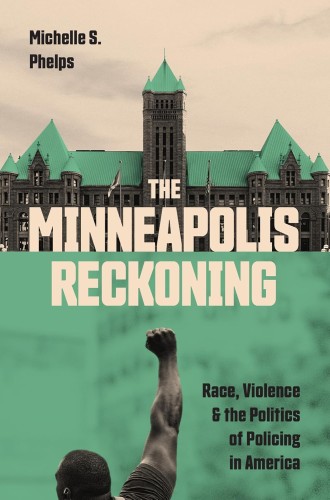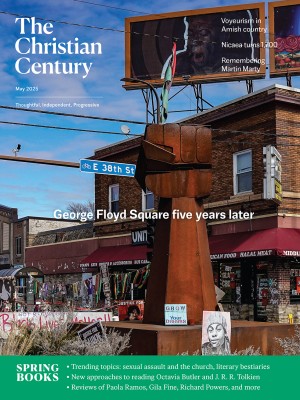Police reform in Minneapolis and beyond
Sociologist Michelle Phelps analyzes the racial and political factors in reform efforts both before and after George Floyd’s murder.

The Minneapolis Reckoning
Race, Violence, and the Politics of Policing in America
In The Minneapolis Reckoning, Michelle Phelps offers an incredibly compelling description of the many acts of resistance, and the responses prompted by that resistance, that arose from the murder of George Floyd on May 25, 2020, in Minneapolis. Floyd’s death at the hands of police sparked widespread protests and movements advocating for racial justice and police reform around the world. In Floyd’s death, Americans once again witnessed the regrettably recurring reality of police violence against Black men. The horrific scene captured on a young woman’s cell phone captivated the attention of the American public. It catalyzed considerations of police reform in Minneapolis while inviting Americans across political, economic, and racial lines to imagine the possibilities of reinvented or reformed models of public safety in America.
Instead of simply providing a historical chronicle of this tragic event, Phelps successfully captures the complex tapestry of interests and individuals instrumental to the pursuit of police reform in Minneapolis. While her commitment to police reform is evident throughout her writing, one of the many commendable aspects of this work is the nuance and balance she brings to presenting the complexity of views of police violence and possible remedies. She reveals the ways communal, racial, and political interests operated in both predictable and unpredictable ways to advance and frustrate efforts to reimagine the provision of public safety in Minneapolis. Phelps helps readers to understand that the complexity arising from considerations of police reform is born of complementary and contradictory ideas: the need to combat the police violence that has long been disproportionally experienced in communities of color, and the calls from within these same communities for the provision of public safety.
Read our latest issue or browse back issues.
Over the course of six chapters, Phelps traces the evolution of efforts at police reform in Minneapolis. She begins by charting the historical disparity in policing in Black communities, sharing a New York Times report published after Floyd’s murder that documents the racial disparity in use of force incidents experienced by Black people at the hands of the Minneapolis Police Department. While constituting only 20 percent of the population of the city, Black people represented 60 percent of these incidents from 2015 to 2020. Phelps concomitantly notes that Black citizens were also disproportionately the victims of violence at the hands of other community members, with a murder rate 25 times higher than that of White citizens. This is one of the many documented realities presented in Phelps’s work that illustrates the need for both police reform and better police service in these communities. These competing needs often left Black residents with an ambivalence toward policing in the city. Many of them viewed the MPD as a necessary evil.
These were not new realities for the citizens of Minneapolis but rather the result of decades of the malignant materialities of Black life there. Part of that malignancy was MPD’s existence as the only city department under the control of the mayor, resulting in the MPD and its engagement with Black citizens being “only as just as its mayor.” This centralized political control of the MPD, along with the rise in the political power of its union, ensured the department’s constant conflict with reform efforts. Even in a city with a history of progressive politics, there remained a refusal to acknowledge the systemic problems present in the operations of the MPD. Additionally, the city’s charter requirement for the maintenance of a certain level of police presence in the city served as another impediment and future flash point in addressing MPD reform.
Phelps addresses the long history of police violence in the city that gave urgency to reform movements. Well before Floyd’s murder or that of Michael Brown in Ferguson, Missouri, Minneapolis had a long and sordid history of deaths of Black people at the hands of the MPD. A variety of organizations arose to address the concerns of police violence. Some of these efforts represented the abolitionist aspiration of not merely reform but a radical reimagining of the structure of policing in Minneapolis. Other movements, equally committed to improved policing in the city, posited that true reform had never fully occurred in Minneapolis because of entrenched political and police power in the city. The variety of approaches to these movements and the portions of the community supporting them are vividly displayed in Phelps’s chronicle of efforts to modify the city’s charter to remove the commitment to a certain level of police presence and, by extension, investment in the current structure of policing in the city. While efforts at reducing and redirecting financial investment in police presence in the city eventually succeeded, Phelps shows how these efforts suffered from the lack of a unified vision of what policing should look like if structural changes occurred.
Phelps leaves readers with several lessons emerging from her thorough examination of the Minneapolis experience. She reaffirms the urgency of this type of discourse, given the ongoing plague of police violence. She explains several of the efforts in Minneapolis to redirect resources to other possible approaches to public safety that aim to mitigate police violence. To her credit, she also provides a clear-eyed evaluation of both the possibilities and the problems inherent to the implementation of each. Her work does not abandon the possibility that we might one day live in an American society that courageously reimagines policing in an effort to reduce the intolerable reality that far too many Black lives are sacrificed at the hands of police violence. But she does not shy away from the magnitude of the problem or the complexity of the solutions envisioned by so many.





